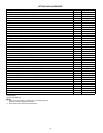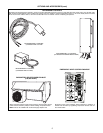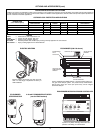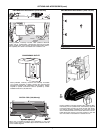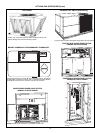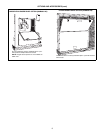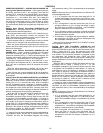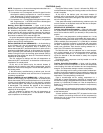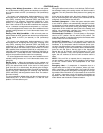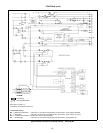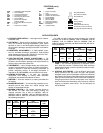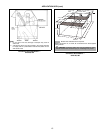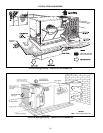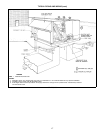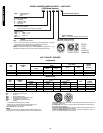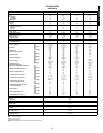12
CONTROLS (cont)
Heating, Units Without Economizer —
With unit main power
on, set thermostat at HEAT position and desired room tempera-
ture. Set fan switch at AUTO. (on demand) or ON (continuous)
position.
On a drop in room temperature, heating contactor no. 1 in the
thermostat closes, energizing heat relay (HR), reversing valve
relay (RVR), reversing valve solenoids (RVS1 and RVS2) and
compressor no. 2 contactor. Compressor (542J150) or com-
pressor no. 2 (542J180) and indoor and outdoor fan motors
start. If the 5-minute CTD on the DB is satisfied, then compres-
sor no. 1 contactor is energized and compressor no. 1 will start.
On units equipped with electric heat, when additional heat is
needed, heating contactor no. 2 in the thermostat closes, ener-
gizing W2.
Heating, Units With EconoMi$er —
With unit main power on,
set thermostat at HEAT position and desired room temperature.
Set fan switch at AUTO. (on demand) or ON (continuous)
position.
On a drop in room temperature, heating contactor no. 1 in the
thermostat closes, energizing heat relay (HR), reversing valve
relay (RVR), reversing valve solenoids (RVS1 and RVS2) and
compressor no. 2 contactor. Compressor no. 2 (542J180) and
indoor and outdoor fan motors start. If the 5-minute CTD on the
DB is satisfied, then compressor (542J150) or compressor no. 1
(542J180) contactor is energized and compressor (542J150) or
compressor no. 1 (542J180) will start. The outdoor-air damper
stays at vent position while the indoor fan is operating.
On units equipped with electric heat, when additional heat is
needed, heating contactor no. 2 in the thermostat closes, ener-
gizing W2.
Defrost Cycle —
When the temperature of the outdoor coil
drops below 28 F as sensed by the defrost thermostat (DFT1 or
DFT2), the defrost timer starts. At the end of a timed period
(field set at 30, 50, or 90 minutes), the defrost cycle will begin.
The defrost board energizes terminals O and W2, energizes the
defrost relay (DR), deenergizes the reversing valve solenoids
(RVS1 and RVS2), and energizes the electric heat. The outdoor-
fan motor will stop.
The unit continues to defrost either until the coil temperature as
measured by DFT1 or DFT2 reaches 65 F, or until unit com-
pletes a 10-minute defrost cycle.
During the defrost mode, when a circuit defrosts, RVS will oscil-
late between heating and cooling modes until defrost mode is
complete. This will prevent the head pressure from getting too
high.
At the end of the defrost cycle, the electric heaters (if applica-
ble) will be deenergized, the reversing valve solenoids will be
energized, and the outdoor fans will start.
Automatic Changeover —
When the system selection switch
is set at AUTO. position, unit automatically changes from heat-
ing operation to cooling operation when the temperature of the
conditioned space rises to the cooling level setting. When the
temperature of the conditioned space falls to the heating level
setting, unit automatically changes from cooling to heating
operation (with a 3 F deadband in between).
Continuous Air Circulation —
Turn unit power on. Set system
control at OFF position. Set fan switch at ON position. The
indoor-fan contactor is energized through the thermostat switch
and the indoor fan runs continuously.
Cycle-LOC™ Protection —
If unit operation is interrupted by
an open high-pressure switch, low-pressure switch, indoor coil
freezestat, or by compressor internal line-break device (over-
current or overtemperature), and compressor is calling for either
cooling or heating, Cycle-LOC protection device simultaneously
locks out unit and lights a warning light on the thermostat.
Restart the unit by manually turning thermostat to OFF and
then to ON position. If any of the protective devices opens
again, the unit continues to lock out until corrective action is
taken.
NOTE:
If the unit fails to operate due to compressor over-
current condition, restart by manually resetting circuit breakers
at the unit. Restart cannot be accomplished at the room
thermostat.
Emergency Heat —
If compressor is inoperative due to a
tripped safety device (high or low pressure, indoor coil freez-
estat, overcurrent, or overtemperature), the Cycle-LOC device
locks out the compressor and lights a warning light on the room
thermostat. When the switch is on (thermostat is set to the EM
HT position), compressor circuit and outdoor thermostats are
bypassed, and the second stage of thermostat energizes the
indoor blower and the electric resistance heaters.



